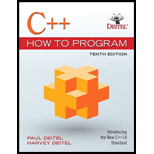
C++ How to Program (10th Edition)
10th Edition
ISBN: 9780134448237
Author: Paul J. Deitel, Harvey Deitel
Publisher: PEARSON
expand_more
expand_more
format_list_bulleted
Question
Chapter 6, Problem 6.36E
Program Plan Intro
- In the program, we include the header files as needed.
- Function prototype will be declared.
- Declaring main() function as integer type.
- Variable declaration: declaring variablesuser_base_num, user_exponent_num as integer type which will take input from user.
- Calling the recursion_power_cal() in the main().
- recursion_power_cal() this function will help to calculate the recursive function of power.
- declaring the variable carry_base, carry_exponent as integer in recursion_power_cal() function definition as integer type which will carry the user input to the function to calculate the result.
Expert Solution & Answer
Want to see the full answer?
Check out a sample textbook solution
Students have asked these similar questions
I need help to solve the following case, thank you
hi I would like to get help to resolve the following case
Could you help me to know features of the following concepts:
- defragmenting.
- dynamic disk.
- hardware RAID
Chapter 6 Solutions
C++ How to Program (10th Edition)
Ch. 6 - Show the value of x after each of the following...Ch. 6 - (Parking Charges) A parking garage charges a...Ch. 6 - Prob. 6.13ECh. 6 - (Rounding Numbers) Function floor can be used to...Ch. 6 - Prob. 6.15ECh. 6 - (Random Numbers) Write statement that assign...Ch. 6 - (Random Numbers) Write a single statement that...Ch. 6 - Prob. 6.18ECh. 6 - Prob. 6.19ECh. 6 - Prob. 6.20E
Ch. 6 - Prob. 6.21ECh. 6 - Prob. 6.22ECh. 6 - Prob. 6.23ECh. 6 - (Separating Digits) Write program segments that...Ch. 6 - (Calculating Number of Seconds) Write a function...Ch. 6 - (Celsius and Fahrenheit Temperature) Implement the...Ch. 6 - (Find the Minimum) Write a program that inputs...Ch. 6 - Prob. 6.28ECh. 6 - (Prime Numbers) An integer is said to be prime if...Ch. 6 - Prob. 6.30ECh. 6 - Prob. 6.31ECh. 6 - (Quality Points for Numeric Grades) Write a...Ch. 6 - Prob. 6.33ECh. 6 - (Guess-the-Number Game) Write a program that plays...Ch. 6 - (Guess-the-Number Game Modification) Modify the...Ch. 6 - Prob. 6.36ECh. 6 - Prob. 6.37ECh. 6 - Prob. 6.38ECh. 6 - Prob. 6.39ECh. 6 - Prob. 6.40ECh. 6 - Prob. 6.41ECh. 6 - Prob. 6.42ECh. 6 - Prob. 6.43ECh. 6 - Prob. 6.44ECh. 6 - (Math Library Functions) Write a program that...Ch. 6 - (Find the Error) Find the error in each of the...Ch. 6 - (Craps Game Modification) Modify the craps program...Ch. 6 - (Circle Area) Write a C++ program that prompts the...Ch. 6 - (pass-by-Value vs. Pass-by-Reference) Write a...Ch. 6 - (Unary Scope Resolution Operator) What’s the...Ch. 6 - (Function Templateminimum) Write a program that...Ch. 6 - Prob. 6.52ECh. 6 - (Find the Error) Determine whether the following...Ch. 6 - (C++ Random Numbers: Modified Craps Game) Modify...Ch. 6 - (C++ Scoped enum) Create a scoped enum named...Ch. 6 - (Function Prototype and Definitions) Explain the...Ch. 6 - Prob. 6.57MADCh. 6 - Prob. 6.58MADCh. 6 - (Computer-Assisted Instruction: Monitoring Student...Ch. 6 - (Computer-Assisted Instruction: Difficulty Levels)...Ch. 6 - (Computer-Assisted Instruction: Varying the Types...
Knowledge Booster
Similar questions
- what is a feature in the Windows Server Security Compliance Toolkit, thank you.arrow_forwardYou will write a program that allows the user to keep track of college locations and details about each location. To begin you will create a College python class that keeps track of the csollege's unique id number, name, address, phone number, maximum students, and average tuition cost. Once you have built the College class, you will write a program that stores College objects in a dictionary while using the College's unique id number as the key. The program should display a menu in this order that lets the user: 1) Add a new College 2) Look up a College 4) Delete an existing College 5) Change an existing College's name, address, phone number, maximum guests, and average tuition cost. 6) Exit the programarrow_forwardShow all the workarrow_forward
- Show all the workarrow_forward[5 marks] Give a recursive definition for the language anb2n where n = 1, 2, 3, ... over the alphabet Ó={a, b}. 2) [12 marks] Consider the following languages over the alphabet ={a ,b}, (i) The language of all words that begin and end an a (ii) The language where every a in a word is immediately followed by at least one b. (a) Express each as a Regular Expression (b) Draw an FA for each language (c) For Language (i), draw a TG using at most 3 states (d) For Language (ii), construct a CFG.arrow_forwardQuestion 1 Generate a random sample of standard lognormal data (rlnorm()) for sample size n = 100. Construct histogram estimates of density for this sample using Sturges’ Rule, Scott’s Normal Reference Rule, and the FD Rule. Question 2 Construct a frequency polygon density estimate for the sample in Question 1, using bin width determined by Sturges’ Rule.arrow_forward
- Generate a random sample of standard lognormal data (rlnorm()) for sample size n = 100. Construct histogram estimates of density for this sample using Sturges’ Rule, Scott’s Normal Reference Rule, and the FD Rule.arrow_forwardCan I get help with this case please, thank youarrow_forwardI need help to solve the following, thank youarrow_forward
arrow_back_ios
SEE MORE QUESTIONS
arrow_forward_ios
Recommended textbooks for you
 C++ Programming: From Problem Analysis to Program...Computer ScienceISBN:9781337102087Author:D. S. MalikPublisher:Cengage Learning
C++ Programming: From Problem Analysis to Program...Computer ScienceISBN:9781337102087Author:D. S. MalikPublisher:Cengage Learning C++ for Engineers and ScientistsComputer ScienceISBN:9781133187844Author:Bronson, Gary J.Publisher:Course Technology PtrProgramming Logic & Design ComprehensiveComputer ScienceISBN:9781337669405Author:FARRELLPublisher:Cengage
C++ for Engineers and ScientistsComputer ScienceISBN:9781133187844Author:Bronson, Gary J.Publisher:Course Technology PtrProgramming Logic & Design ComprehensiveComputer ScienceISBN:9781337669405Author:FARRELLPublisher:Cengage Microsoft Visual C#Computer ScienceISBN:9781337102100Author:Joyce, Farrell.Publisher:Cengage Learning,
Microsoft Visual C#Computer ScienceISBN:9781337102100Author:Joyce, Farrell.Publisher:Cengage Learning,

C++ Programming: From Problem Analysis to Program...
Computer Science
ISBN:9781337102087
Author:D. S. Malik
Publisher:Cengage Learning

C++ for Engineers and Scientists
Computer Science
ISBN:9781133187844
Author:Bronson, Gary J.
Publisher:Course Technology Ptr

Programming Logic & Design Comprehensive
Computer Science
ISBN:9781337669405
Author:FARRELL
Publisher:Cengage

Microsoft Visual C#
Computer Science
ISBN:9781337102100
Author:Joyce, Farrell.
Publisher:Cengage Learning,